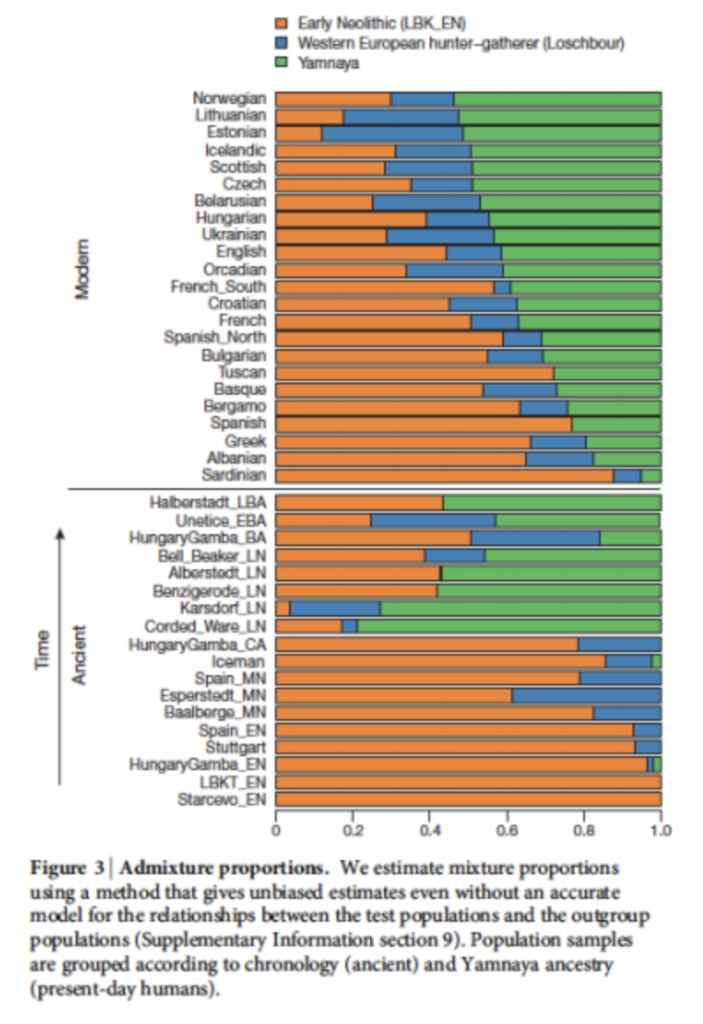40,000 years ago, a group of hunter-gatherers, with brown eyes and dark skin and hair, descendants of migrations that left Africa 100,000 years ago, settled in the Pontic Steppe along the Black Sea, passing through Central Asia, where they encountered and mixed with the Neanderthal man already established in these lands. Recent genetic research, conducted by David Reich, shows that around 10,000 BC, a mutation gave them blue eyes and that between 9000 and 7000 BC, their DNA slowly mixed with another farming people from the plains of Anatolia, with pale skin, brown eyes, and dark hair, after a period of cohabitation. Finally, 5,000 years ago, in the Bronze Age, a people from the steppes of Central Eurasia, sheep herders, mounted on chariots pulled by horses thanks to the invention of the wheel, adorned with jewelry and with predominantly pale skin, dark hair, and brown eyes, covering their dead with ochre during funeral rites, took over Europe and imposed their culture. They dominated and ultimately replaced the existing people all the way to Spain where, in one way or another, they had a reproduction advantage, giving them an almost exclusive role in reproduction with indigenous women. Coming from the Yamna culture, they were the Yamnayas, the proto-Indo-Europeans who colonized Europe.
How do we know about the Yamnayas?
The Yamnayas are what we call in genetics, a ghost people. That is, a vanished people whose past existence can be identified and proven thanks to the “traces” of genetic material found in ancient DNA. Fragments of bone containing this ancient DNA have been found in several places where the Corded Ware culture developed, in southern Poland and Moravia, and other fragments attributed to individuals from the Yamna, Catacomb, Babyno, and Noua cultures.

New DNA sequencing technologies, including the ability to read DNA in ancient bones, have shed more light on the kinship of the Yamnayas with modern Europeans. A 2015 study led by Daniel Zadik, from the University of Leicester, highlighted that the genes of the Yamnayas are present in the majority of Europeans today. Thanks to “Next-Generation Sequencing” technology, Daniel Zadik was able to identify several mutations within the genome of Europeans and generate a more precise “genealogical” tree than ever before.

Two thirds of modern Europeans fall under 3 branches (called I1, R1a, and R1b). These results show that each branch traces back to a recent paternal ancestor, depicted by a red point on the graph (Figure 2). By counting the number of mutations accumulated within each branch, it is estimated that these three individuals lived at different times between 7300 and 3500 years ago. The lineage of each seems to have exploded in the centuries following their deaths, eventually dominating Europe. The R1a and R1b branches are the most represented among current Europeans, with a predominance of R1b among Western Europeans and R1a among Eastern Europeans. These two branches are directly linked to Yamnaya ancestors. This explains the low genetic variation among all Europeans observed by Daniel Zadik and David Reich. But what exactly do we know about this proto-Indo-European people?
The Yamnayas were a mixed people.
For a long time, it was believed that the Yamnayas were a “pure” people. However, they were a mix of three groups of Eastern and Caucasian hunter-gatherers. The genome of the Caucasian hunter-gatherers shows continuous mixing with their Middle Eastern cousins who invented agriculture 10,000 years ago. However, this mixing stopped 25,000 years ago, right before the peak of the Ice Age. At that time, populations saw their numbers dwindle, as evidenced by the way their genes homogenized during this period, indicating very endogamous mating within a restricted group.
Once the ice receded, these Caucasian tribes once again contacted other groups of hunter-gatherers living in the steppes and mixed with another people who had spent the Ice Age in isolation, thus laying the genetic foundation for the Yamnaya people.
A proto-capitalist nomadic people who established their supremacy from Europe to India.
One of the most heated debates emerged from initial studies on the Yamnaya culture. It focused on the relationship between the Yamnaya and late Neolithic cultures of Central Europe, like the Corded Ware culture. Genetics either confirms scenarios suggested by archaeological studies or provides new insights. Through these studies, we’ve learned about similarities in past cultures, such as the presence of elongated mounds and consistent funeral rites. Today, we know with certainty that the individuals of the Corded Ware culture are, in fact, genetically close to the Yamnayas ,and are therefore a the descendants of a westward extension of this people.
Ancient DNA data indicates that Neolithic populations of Central Europe already had a “Caucasian” component around 2500 BC. This component was used to validate the theory of the expansion of this Pontic steppe people into Central Europe. Sequences from the X chromosome suggest that these expansions were primarily driven by men. For each migrating woman, between 4 and 15 men migrated from the steppes to Central Europe and Western Asia.
What drove this swift expansion during the Bronze Age? A new economic system emerged, characterized by heightened human movement and wealth accumulation. This shift was propelled by the domestication of horses, the advent of the wheel and vehicles, and access to metals like copper and tin—essential for bronze production. Y chromosome studies indicate significant inequality during this period. A select group of men harnessed this new economy, replacing Northern European farmers and Western European hunter-gatherers as far as India, thereby spreading the Indo-European language.
A Violent, Sexist, and Stratified Yamna Culture
This expansion could not have been entirely amicable given the marked proportion of Y-chromosome origins from the Yamnaya people, both among Western Europeans and in today’s upper Indian castes. The dominance of Yamnaya male ancestors implies that they passed on a superior socio-political status to their offspring, allowing them, at the very least, to maintain an advantage in reproductive competition. The most striking example is in Spain. David Reich conducted research on the ancient DNA of Iberian populations present between -4500 and -4000 years ago. He noticed that the Iberian population had a percentage of about 15% of genes inherited from the Yamnayas. However, 90% of the men with Yamnaya genes had a Y chromosome from this steppe people. This indicates a strong hierarchy and inequality in the Yamnaya expansion.

Archaeologist Marija Gimbutas posits that the Yamnayas were profoundly patriarchal and hierarchical. Their notable “Kurgans” or burial mounds largely (about 80%) contain male skeletons at their core, many bearing signs of violent injuries and accompanied by metal daggers and bows. Gimbutas’ thesis, while contentious, suggests that the Yamnayas introduced a significant shift in male-female dynamics. However, interpreting a culture without textual evidence is tricky. This perspective has faced criticism, with archaeologists like Peter Ucko and Andrew Fleming challenging it. Gimbutas also speaks of the decline of “Old Europe,” which she depicts as a society with minimal evidence of violence and a prominent role for women—highlighted by the Venus figurines. In her view, “Old Europe” was supplanted by a male-dominated society, traces of which can be seen not just in archaeological findings but also in subsequent cultures, as reflected in Greek, Nordic, and Hindu mythologies, all spoken by descendants of the Indo-European language group.
Cannabis users?
It’s likely that the Yamnayas consumed cannabis, but whether they used it for its psychoactive effects is uncertain. Cannabis has been linked to various uses, from shamanic rituals to medicinal applications. What we do know is that cannabis use intensified in Eurasia around the same time as the Yamnaya expansion. This correlation suggests that they might have played a significant role in its propagation. Some researchers even theorize that the Yamnayas might have used cannabis as a trade item, possibly making them among the earliest to distribute it.
Where is the most Yamnaya DNA found in Europe today?
Among modern Europeans, the people with the highest rate of Yamnaya DNA are the Norwegians, who are attributed with 50% DNA from this steppe people, followed by the Scots and the Irish where the highest rate of red-haired and blonde individuals is found, which would be a trait inherited from this people, as well as the Icelanders who are a people formed by the Vikings mixed with Scottish and Irish women. If you are a man, there is a high chance that your chromosome comes from them.

Sources:
1. A handful of Bronze-Age men could have fathered two-thirds of Europeans https://theconversation.com/a-handful-of-bronze-age-men-could-have-fathered-two-thirds-of-europeans-42079
2. Europe’s fourth ancestral ‘tribe’ uncovered https://www.bbc.co.uk/news/science-environment-34832781
3. Spanish Men Were Completely Wiped Out By The Arrival Of A New Tribe 4,000 Years Ago https://www.iflscience.com/plants-and-animals/spanish-men-were-completely-wiped-out-by-the-arrival-of-a-new-tribe-4000-years-ago/
4. Ancient migration transformed Spain’s DNA https://www.bbc.co.uk/news/science-environment-47540792
5. Mitochondrial genomes reveal an east to west cline of steppe ancestry in Corded Ware populations https://www.nature.com/articles/s41598-018-29914-5
6. Yamnaya, Light Skinned, Brown Eyed….Ancestors??? https://dna-explained.com/2015/06/15/yamnaya-light-skinned-brown-eyed-ancestors/
7. Ancient European genomes reveal jumbled ancestry https://www.nature.com/news/ancient-european-genomes-reveal-jumbled-ancestry-1.14456
8. Yamna culture https://www.eupedia.com/genetics/yamna_culture.shtml
9. European genetic identity may stretch back 36,000 years
10. Who we are and how we got here, David Reich, 2018
11. A brief history of everyone who ever lived, Adam Rutherford, 2018



